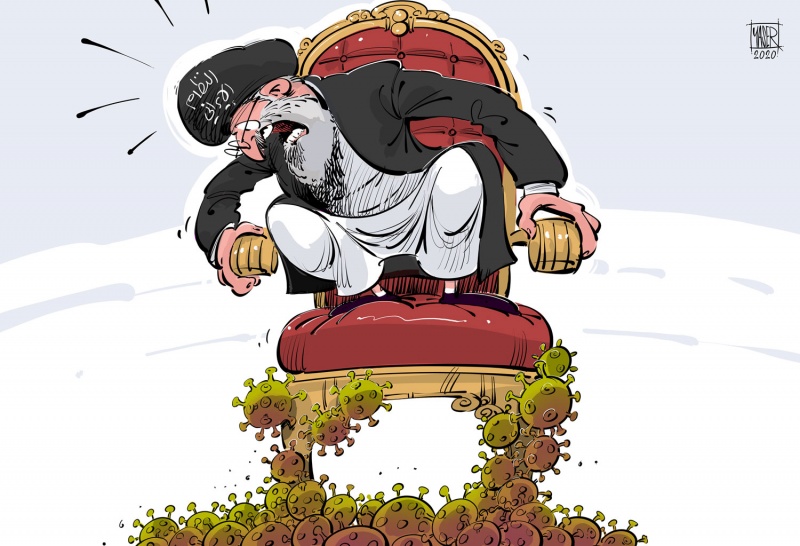Iranian regime facing a three-dimensional crisis
Dr. Majid Rafizadeh/Arab News/April 15, 2020
د.ماجد رافيزادا: الحكم في إيران يواجه أزمة ثلاثية الأبعاد
The Iranian regime is currently facing the highest level of pressure it has experienced in decades. It is encountering three major problems, which are interacting with each other, intensifying the overall crisis and creating a vicious circle for Tehran’s leaders. The regime’s survival will be in great danger if the authorities fail to handle at least one of the dimensions of the crisis.
The newest facet that has been added to Iran’s crisis is related to the regime’s views on public health. Before the coronavirus disease (COVID-19) outbreak, the Iranian leaders boasted about the government’s efforts and desire to improve the nation’s health standards. One of the pledges made by President Hassan Rouhani in his first presidential term was to provide health care to all Iranians.
To take credit for this move, he called the program “RouhaniCare.” He tweeted in 2014: “(The government) will extend medical insurance to all Iranians. First step will be to cover 5 million uninsured Iranians by the social safety net #RouhaniCare.”
But, thanks to its mishandling of the coronavirus pandemic, the overwhelming majority of the Iranian people seem to have come to the conclusion that the regime is more concerned about its own survival than the health of its citizens. Mahnaz, an Iranian nurse from the province of Esfahan, said: “The government claims that it did not know about the spread of the coronavirus in Iran till late February. But there is evidence that the leadership knew about the existence of coronavirus in the country in early January. They decided not to inform the public. Now many see how the mullahs did not care about the public’s health.”
The regime most likely kept its citizens in the dark for its own political gains. The parliamentary elections were on their way in late February and, if the regime had warned the public about the impending health crisis, it would have negatively affected voter turnout. Instead, the ruling mullahs wanted to strengthen the hard-liners’ base and project to the international community that it enjoys a high level of legitimacy.
Supreme Leader Ali Khamenei previously described his view that elections are “very important in our country. Not only presidential elections but also parliamentary and city and village council elections. Elections are one of the two pillars of religious democracy… We boast to the whole world thanks to elections.
In order to strike the people of Iran and the Islamic Republic, the enemies ignore and accuse our elections.”
The second problem facing the regime is public resentment toward it. This has increased because, instead of responding to the Iranian citizens’ legitimate demands, the authorities have escalated their use of lethal force, suppression and human rights abuses.
This was highlighted when some 35 prisoners were reportedly killed by the regime’s security forces for protesting over fears of contracting COVID-19.
A report by Amnesty International last week described what happened: “In recent days, thousands of prisoners in at least eight prisons around the country have staged protests over fears of contracting the coronavirus, sparking deadly responses from prison officers and security forces. In several prisons, live ammunition and tear gas were used to suppress protests, killing around 35 prisoners and injuring hundreds of others, according to credible sources.”
The third dimension of Iran’s crisis is linked to the country’s economic outlook, which has become much worse thanks to the coronavirus crisis. Even before the pandemic, in October last year, the International Monetary Fund (IMF) adjusted its forecast for Iran’s economy, stating that it was expected to shrink by 9.5 percent in 2019, rather 6 percent as previously predicted.
Meanwhile, the Trump administration’s maximum pressure policy continues, with the US not extending its sanctions waivers for Iran’s eight biggest oil customers. And, in the last two months, Iran’s currency has suffered a sharp fall in value. In January, $1 was worth about 90,000 rials, but now it is nearly 160,000. This is why the regime has been rushing to reopen businesses, with Rouhani last week stating: “We want to continue economic activities as much as possible while fighting coronavirus at the same time.” This swift move will more likely put the public at greater risk of contracting the virus.
The authorities have escalated their use of lethal force, suppression and human rights abuses.
The Iranian government has also been asking international organizations, such as the IMF and other governments, for an emergency loan. But Iran’s economy will be massively hit because the IMF is unlikely to provide money to the regime. The US government is seeking to block the funding to Tehran, with an official in the Trump administration saying: “The world’s leading state sponsor of terrorism is seeking cash to fund its adventurism abroad, not to buy medicine for Iranians.”
If not handled immediately, these three problems could combine to bring about a crisis that will bring the theocratic establishment to its knees.
*Dr. Majid Rafizadeh is an Iranian-American political scientist. He is a leading expert on Iran and US foreign policy, a businessman and president of the International American Council. Twitter: @Dr_Rafizadeh






















